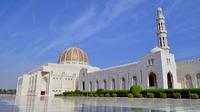Small Group Tour: Fascinating Muscat City Tour
Muscat, Oman
Rating: 







Trip Type: City Tours
Duration: 5 hours
Muscat is the capital of Oman and rich in history and culture. It is one of the most important cities in the Old Orient and lies in the north-eastern part of the country on the Gulf of Oman.
More About This Activity All City Tours →
Muscat is the capital of Oman and rich in history and culture. It is one of the most important cities in the Old Orient and lies in the north-eastern part of the country on the Gulf of Oman.
The first stop on the Muscat City Tour is the Grand Mosque, a most beautiful architectural piece of work. The Mosque was built over a period of 6 years from 1995 to 2001. The main chandelier is made of pure Swarovski crystal and the carpet adorning the large prayer hall was woven by experts, made out of pure Persian silk. The Mosque exterior is constructed with quality Rajasthani Sandstone and the main halls as well as the smaller prayer rooms are adorned with the finest Italian Marble. The Mosque is surrounded by 5 minarets’, each of which symbolizes the holy five vows taken by every devout Muslim to reinforce his faith in the Almighty. Definitely a “must see!”
From the Mosque, proceed through the Embassy road (please note that it is forbidden to take photographs) to the old part of Muscat city: The Muttrah souk - a traditional Omani market. The souk offers a wide range of goods, especially typical Omani souvenirs like Frankincense, the Omani Dagger or Khanjar and beautiful silver handicrafts and “Pashmina shawls”. The guide will escort you on the stroll through the souk and assist wherever needed to obtain the best deal (bargaining is part of the daily trade here!).
The next stop is the Bait Al Zubair Museum. The museum is a small townhouse that has been converted to display the old archaeological findings and Omani traditions such as national dress and jewellery. The Museum also has an interesting display of old pictures of Muscat before the renaissance that started with his Majesty the Sultan Qaboos’s reign in 1970.
From here you shall proceed to see the Sultan’s Palace (video filming is prohibited) surrounded by the 2 Forts of Mirani and Jalali built by the Portuguese in the 16th century during their rule of the coastal cities of Oman.
From the Mosque, proceed through the Embassy road (please note that it is forbidden to take photographs) to the old part of Muscat city: The Muttrah souk - a traditional Omani market. The souk offers a wide range of goods, especially typical Omani souvenirs like Frankincense, the Omani Dagger or Khanjar and beautiful silver handicrafts and “Pashmina shawls”. The guide will escort you on the stroll through the souk and assist wherever needed to obtain the best deal (bargaining is part of the daily trade here!).
The next stop is the Bait Al Zubair Museum. The museum is a small townhouse that has been converted to display the old archaeological findings and Omani traditions such as national dress and jewellery. The Museum also has an interesting display of old pictures of Muscat before the renaissance that started with his Majesty the Sultan Qaboos’s reign in 1970.
From here you shall proceed to see the Sultan’s Palace (video filming is prohibited) surrounded by the 2 Forts of Mirani and Jalali built by the Portuguese in the 16th century during their rule of the coastal cities of Oman.
« Go Back

